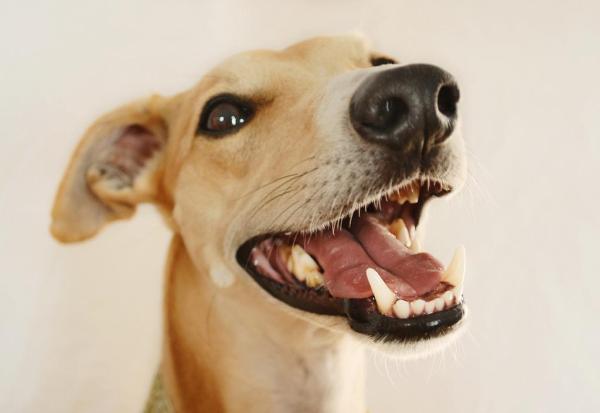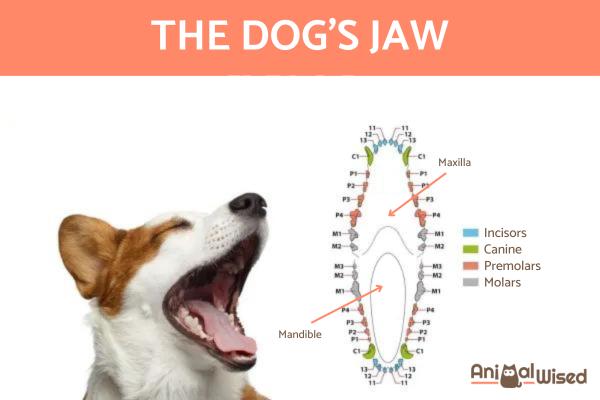How Many Teeth Do Dogs Have?



See files for Dogs
As you know, the teeth of animals are specially adapted to the type of food they eat. Dogs, being carnivores, have incisors and canines with which they can grasp, tear and rip meat, and premolars and molars with which they can cut and grind food. Our dog's teeth can tell us a lot about our dog's health, age, and diet. But how many teeth does a dog have? What are their functions?
Find out this and more in the following AnimalWised article, where we tell you how many teeth dogs have, as well as their functions and main characteristics.
How many teeth do dogs have?
The dentition of dogs has some characteristics similar to those of humans. First of all, dogs are also heterodont. This means that they have teeth of different shapes and sizes depending on their function. Canine teeth are divided into four groups:
- Incisor
- Canines (also known as fangs)
- Premolar
- Molar
Dental formula is a method of describing the number and arrangement of teeth in humans and animals using letters and numbers. It is written as an expression of the number of each type of tooth on one side of the upper jaw versus the number of teeth on one side of the lower jaw. To interpret this scheme, we must consider the following points:
- The letters correspond to the previously mentioned tooth types, i.e.: (I) incisor, (C) canine, (P) premolar, (M) molar.
- The terms numerator and denominator refer respectively to the upper arch (maxilla) and the lower arch (mandible).
- Both the numerator and denominator refer to only half of the arch (i.e., half of the maxilla and half of the mandible, respectively). They are symmetrical, meaning that there are as many teeth on the left side as on the right side. Therefore, to find out how many teeth dogs have in total, you need to multiply the tooth formula by 2.
It is also important to point out that dogs, like most mammals, have two types of teeth depending on their age. During the embryonic stage of development, dogs develop deciduous teeth, also known as milk teeth. These teeth are later replaced by permanent teeth, also known as adult teeth. The number of teeth in dogs varies depending on whether they are deciduous teeth or permanent teeth.
- The deciduous dentition in dogs follows the formula: 2x (I 3/3, C 1/1, P 3/3). That is, puppies have a total of 28 teeth.
- The permanent dentition in dogs follows the formula: 2x (I 3/3, C 1/1, P 4/4, M 2/3). That is, adult dogs have a total of 42 teeth.
Good oral hygiene is key to preventing your dog's teeth from becoming deformed or falling out. Continue reading in this other article, where we talk about the different ways to clean teeth in dogs.
Do dogs have milk teeth?
As we mentioned in the previous section, dogs are diphyodonts, which means that they have milk teeth. Not only that, they also teethe when they are puppies, just like human babies and children get new teeth during their development. These teeth are pointed and sharp, which is why they are sometimes called needle teeth.
The process of replacing milk teeth with permanent teeth begins around the third month of the dog's life and ends between the sixth and seventh month. This process is developed in the following way:
- 3 weeks: puppies begin teething.
- 6 weeks: all milk teeth have erupted.
- 12 weeks: baby teeth begin to fall out and the permanent teeth erupt.
- 6 months: all permanent teeth have erupted, and all milk teeth have fallen out.
Incisors and canines erupt first, followed by premolars. You may find the baby teeth on the floor, but more likely your puppy will swallow them while eating.
You may also be interested in this other article, where we go into more detail about how teething occurs, and when and how dogs lose their baby teeth.
Main characteristics of dog teeth
Now that you know how many teeth dogs have, let us explain in more detail what are the main features of a dog's dentition. Firstly, it is important to know that all dog teeth consist of three parts:
- Crown: is the visible part of the tooth.
- Root: is the part of the tooth that lies in the alveolar bone of the upper or lower jaw.
- Cervical line: it is the border between the crown and the root.
Now that we know what parts a tooth is made of, we will elaborate on the main characteristics of each part and the materials they are made of:
- Both the crown and the root are essentially composed of dentin, a layer of material that lies immediately underneath the enamel of the tooth.
- The crown is covered by enamel, the hardest and most mineralized tissue in the body.
- The root, on the other hand, is covered by cementum, a bone-like tissue.
- Each tooth's pulp cavity is occupied by the dental pulp, which contains nerves, blood vessels, connective tissue, and odontoblasts, which produce dentin.
- The apparatus that supports and holds each tooth is called the periodontium and consists of the cementum, the periodontal ligament, the alveolar bone, and the gingival tissue.
You may be interested in this other article, where we discuss why some dogs have rotten teeth.

Types of dogs teeth
Although all teeth have the same structure and composition, each type of tooth has specific characteristics depending on its function:
- Incisors: their main function is to nip and bite. They have short crowns, very pronounced necks and a single root.
- Canines: they are used for tearing and shredding flesh. They are large, conical, curved and have a single root. They are separated from the lateral incisor by an interdental space, the diastema.
- Premolars: their function is to shear and crush. They vary in size and number of roots.
- Molars: they are also used for shearing and crushing food. Their number of roots also varies from one to three.
Last but not least, we will define some key terms related to the dentition of the dog
- Diphyodont: refers to the fact that dogs have two consecutive rows of teeth, first the deciduous row and then the permanent row.
- Anelodont: refers to the fact that dogs, unlike other animals such as rabbits, do not have teeth that grow continuously.
- Brachyodont: refers to the fact that the dog's tooth roots are longer than the tooth crowns.
You may also be interested in this other article, where we discuss why puppy teeth are so sharp.
What happens when a dog loses a tooth?
Dogs with healthy teeth should be able to keep their teeth throughout their lives. However, as a dog approaches old age, they are more prone to losing their teeth. Most often they lose the front teeth, that is the incisors.
In most cases, certain pathologies such as periodontitis, gingivitis, and the presence of tartar can lead to the loss of a tooth. This is relatively common in dogs suffering from advanced periodontal disease or in animals that have suffered severe trauma to the oral cavity.
Additionally, if dogs hit something hard or have some kind of accident, that could also cause one or more of their teeth to fall out. This is why it is necessary for the dog's caregiver to watch for the slightest signs in the dog's mouth and gums. Some of these symptoms are:
- Bad breath
- Swollen gums
- Loose teeth
- Chipped teeth
- Excessive salivation
- Bleeding gums
When an adult dog loses one or more teeth, care must be multiplied to prevent any type of infection or further teeth falling out. It is important to visit a veterinary center to determine the cause and find the most appropriate treatment in each case. It is critical that the dog's mouth is examined at regular intervals to determine whether or not all the teeth are present.
If you want to read similar articles to How Many Teeth Do Dogs Have?, we recommend you visit our Facts about the animal kingdom category.
- Brook, A., Gawor, J., Nemec, A., Clarke, D., Tutt, C., Gioso, M., Stegall, P., Chandler, M., Morgenegg, G., Jouppi, R., Stewart, K. (2020). Dental Guidelines of the World Association of Small Animal Veterinarians . World Small Animal Veterinary Association (WSAVA)
- Fernandez, JM (2014). Dentistry in the daily clinic . Association of Spanish Veterinarians Specialists in Small Animals (AVEPA)






